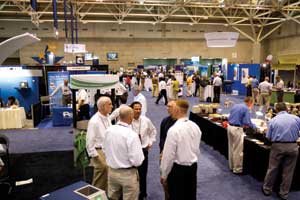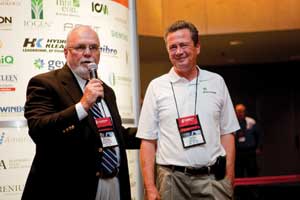Cellulosic Ethanol Viewed from All Angles



July 15, 2010
BY Susanne Retka Schill
Project updates and technology developments in cellulosic ethanol held the attention of those in the room throughout the FEW breakout sessions. In a panel presentation following the opening session, Larry Peckous, vice president of sales for EdeniQ, led a discussion on corn ethanol's metamorphosis to cellulosic production. "Metamorphosis brings to mind the caterpillar which doesn't die, but emerges as a butterfly. Our industry is ready to emerge," he said. EdeniQ recently received U.S. DOE funding for a project to examine the corn-to-cellulose migration. For that migration's success, Doug Rivers, director of research and development at ICM Inc., said the integration of starch and cellulose platforms will provide opportunities for process synergies. Other key areas for success will be the infrastructure for biomass handling, pretreatment and conversion strategies that are scalable and cost effective, Rivers added. Phil Madsen, CEO of Katzen International Inc., closed out the panel by questioning the assumption that ethanol was the best use for cellulose. "In Mother Nature's plan, sugar is to eat today, starch is to store for tomorrow and cellulose is used to build your house and light fires." Cellulose to ethanol is not new, he argued, having been done in the pulp and paper industry for decades. It has not proven economic, Madsen said, pointing to the former Soviet Union where only five of the once 50-some cellulosic plants remain. He suggested it may be more fruitful to expand the use of multiple grain-based feedstocks, work on creating a high starch energy corn and design systems using biomass power.
Several companies offered project updates in the cellulosic track. IneosBio is proposing an 8 MMgy cellulosic ethanol plant that would produce 1 to 2 megawatts of electricity from vegetative waste and municipal solid waste (MSW), a joint venture with New Planet Energy at Vero Beach, Fla. Ineos, the EU's largest ethanol producer, has operated a pilot plant for more than seven years using a gasifier to produce synthesis gas that can be fermented into ethanol. Fiberight is also targeting MSW, an outgrowth of CEO Craig Stuart-Paul's experience in both the recycling and micro-brewery businesses. Fiberight purchased a first generation corn ethanol plant in Iowa that was running a fully integrated 24/7 process during the FEW. "We hope to have the fully integrated system in robust production by the end of 2011," Stuart-Paul said. Mick Sawka, vice president of commercial development at Qteros, described his company's work to enhance a bacteria's ability to produce its own enzymes and convert all five sugars to ethanol in consolidated bioprocessing. The company hopes to integrate a non-genetically modified version of its microbe with corn ethanol production to convert stillage, wet distillers grains and syrup to ethanol, increasing overall ethanol yield by 20 percent and producing about half the distillers grains with higher protein content, requiring less energy overall.
In a panel presenting new ideas in pretreatment, Johan van Groenestijn from TNO, a Netherlands research organization, reported on work with a novel dilute acid pretreatment system allowing high solid concentrations and direct fermentation. Rajai Atalla, Cellulose Sciences International, said the notorious recalcitrance of cellulosic material is a reaction to pretreatment. The CSI understanding of the nanoporous characteristics of cellulosic material has resulted in a process using ambient conditions and inexpensive chemicals. "We expect with optimization and further tuning to substrates, we can reduce enzymatic dosing by a factor of 10," Atalla said. Borregard/LignoTech is taking a different approach in a new pretreatment process to maximize quality lignin production for performance chemicals, according to Gudbrand Rodsrud, making ethanol from C6 sugars and chemicals from C5 sugars. A pilot plant will start construction later this year.
Tim Eggeman, chief technology officer at ZeaChem, summarized the view of many in the 24 presentations that comprised the cellulosic track. While first generation corn ethanol produces enough fuel to run a vehicle 5,000 miles on an acre of land a year, he said, advanced biofuels and technologies will achieve 28,000 miles per acre. Combining the advanced biofuel potential with better gas mileage performance could achieve 50,000 miles per acre of land. "I don't think people see the power of what's coming with cellulosic ethanol down the road," he said.
Several companies offered project updates in the cellulosic track. IneosBio is proposing an 8 MMgy cellulosic ethanol plant that would produce 1 to 2 megawatts of electricity from vegetative waste and municipal solid waste (MSW), a joint venture with New Planet Energy at Vero Beach, Fla. Ineos, the EU's largest ethanol producer, has operated a pilot plant for more than seven years using a gasifier to produce synthesis gas that can be fermented into ethanol. Fiberight is also targeting MSW, an outgrowth of CEO Craig Stuart-Paul's experience in both the recycling and micro-brewery businesses. Fiberight purchased a first generation corn ethanol plant in Iowa that was running a fully integrated 24/7 process during the FEW. "We hope to have the fully integrated system in robust production by the end of 2011," Stuart-Paul said. Mick Sawka, vice president of commercial development at Qteros, described his company's work to enhance a bacteria's ability to produce its own enzymes and convert all five sugars to ethanol in consolidated bioprocessing. The company hopes to integrate a non-genetically modified version of its microbe with corn ethanol production to convert stillage, wet distillers grains and syrup to ethanol, increasing overall ethanol yield by 20 percent and producing about half the distillers grains with higher protein content, requiring less energy overall.
In a panel presenting new ideas in pretreatment, Johan van Groenestijn from TNO, a Netherlands research organization, reported on work with a novel dilute acid pretreatment system allowing high solid concentrations and direct fermentation. Rajai Atalla, Cellulose Sciences International, said the notorious recalcitrance of cellulosic material is a reaction to pretreatment. The CSI understanding of the nanoporous characteristics of cellulosic material has resulted in a process using ambient conditions and inexpensive chemicals. "We expect with optimization and further tuning to substrates, we can reduce enzymatic dosing by a factor of 10," Atalla said. Borregard/LignoTech is taking a different approach in a new pretreatment process to maximize quality lignin production for performance chemicals, according to Gudbrand Rodsrud, making ethanol from C6 sugars and chemicals from C5 sugars. A pilot plant will start construction later this year.
Tim Eggeman, chief technology officer at ZeaChem, summarized the view of many in the 24 presentations that comprised the cellulosic track. While first generation corn ethanol produces enough fuel to run a vehicle 5,000 miles on an acre of land a year, he said, advanced biofuels and technologies will achieve 28,000 miles per acre. Combining the advanced biofuel potential with better gas mileage performance could achieve 50,000 miles per acre of land. "I don't think people see the power of what's coming with cellulosic ethanol down the road," he said.
Advertisement
Advertisement
Advertisement
Advertisement
Upcoming Events





